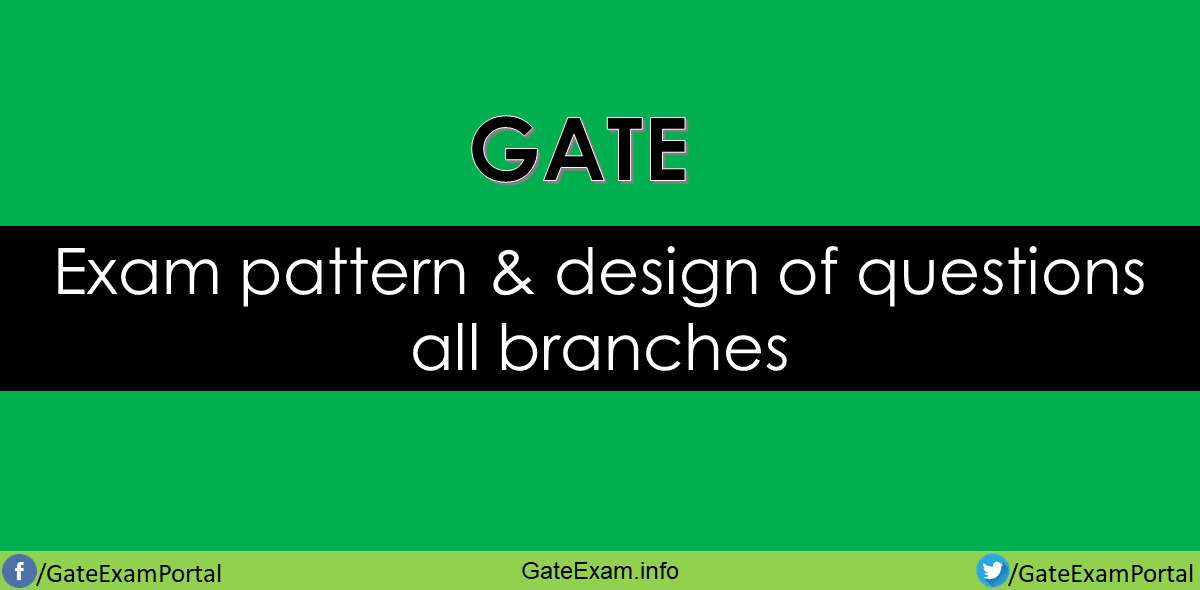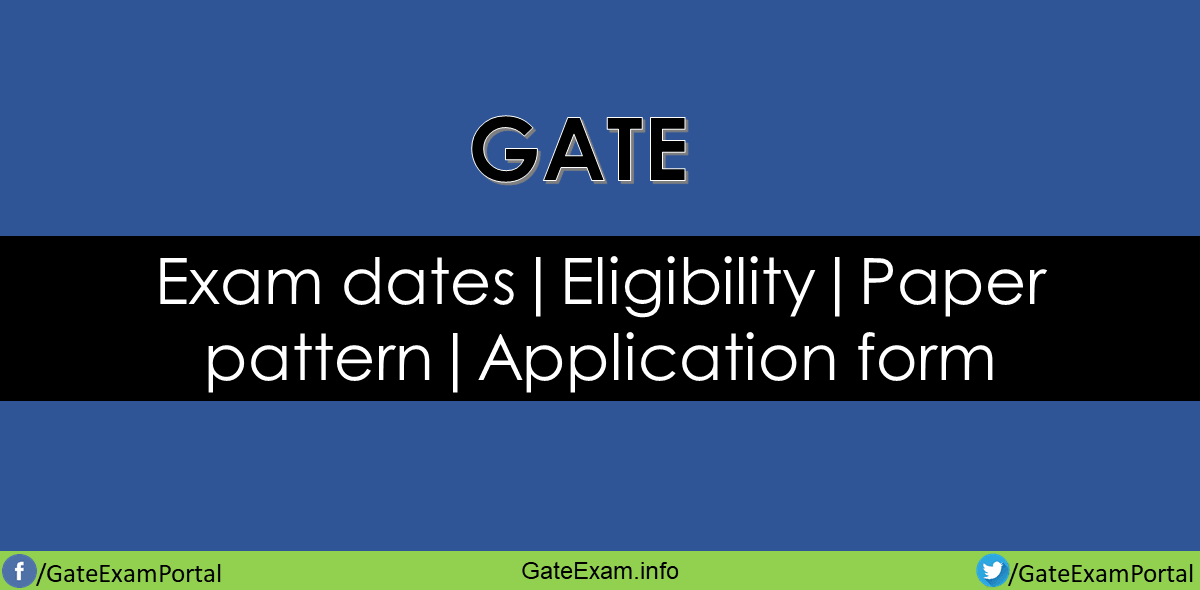The GATE examination is attended by lakhs of students all over the nation. GATE 2021 exam is conducted for 27 papers. As GATE exam has become crucial for entering into PSUs, and to pursue higher education at NITs, IITs, IIITs, and few other deemed universities, it’s very important to have a clear idea about the GATE exam paper pattern, number of questions, etc and plan accordingly to crack this prestigious examination. Here is the GATE exam pattern 2021 for EC, CS, EE, ME, CE and all other branches of engineering.
GATE Exam Pattern 2021
All the papers of the GATE 2021 examination will be for 3 hours duration and they consist of 65 questions and gate total marks are 100. Since the examination is an ONLINE computer-based test, at the end of the stipulated time (3-hours), the computer will automatically close the screen inhibiting any further action.
GATE exam Pattern of Questions for 2021
GATE 2021 would contain questions of three different types in all the papers:
(i) Multiple Choice Questions (MCQ) carrying 1 or 2 marks each in all the papers and sections. These questions are objective in nature, and each will have a choice of four answers, out of which the candidate has to select (mark) the correct answer.
Negative Marking for Wrong Answers: For a wrong answer chosen in a MCQ, there will be negative marking. For 1-mark MCQ, 1/3 mark will be deducted for a wrong answer. Likewise, for 2-mark MCQ, 2/3 mark will be deducted for a wrong answer.
(ii) Multiple Select Questions (MSQ) carrying 1 or 2 marks each in all the papers and sections. These questions are objective in nature, and each will have choice of four answers, out of which ONE or MORE than ONE choice(s) is / are correct.
Note: There is NO negative marking for a wrong answer in MSQ questions. However, there is NO partial credit for choosing partially correct combinations of choices or any single wrong choice.
Example of MSQ :
Which of the following is/are state(s) in India?
(A) Maharashtra (B) Gujarat (C) Mumbai (D) Goa.
Here, the correct answer is the combination of (A), (B) and (D). Candidates will get full marks if and only if this combination is selected. There are NO partial marks in this type of question. The candidates will NOT get any marks for choosing any other option/combination as their answer.
(iii) Numerical Answer Type (NAT) Gate exam pattern: Questions carrying 1 or 2 marks each in all the papers and sections. For these questions, the answer is a signed real number, which needs to be entered by the candidate using the virtual numeric keypad on the monitor (keyboard of the computer will be disabled). No choices will be shown for these type of questions. The answer can be a number such as 10 or -10 (an integer only). The answer may be in decimals as well, for example, 10.1 (one decimal) or 10.01 (two decimals) or -10.001 (three decimals). These questions will be mentioned with, up to which decimal places, the candidates need to present the answer. Also, for some NAT type problems an appropriate range will be considered while evaluating the numerical answer type questions so that the candidate is not unduly penalized due to the usual round-off errors. Wherever required and possible, it is better to give NAT answer up to a maximum of three decimal places.
Example: If the wire diameter of a compressive helical spring is increased by 2%, the change in spring stiffness (in %) is _____ (correct to two decimal places). There is NO negative marking for a wrong answer in NAT questions.
Must check: Gate qualifying marks for each branch
GATE exam pattern of Marks for 2021
In all the papers, there will be a total of 65 questions carrying 100 marks, out of which 10 questions carrying a total of 15 marks will be on General Aptitude (GA), which is intended to test the Language and Analytical Skills.
In the papers bearing the codes AE, AG, BM, BT, CE, CH, CS, EC, EE, ES, IN, ME, MN, MT, PE, PI, TF and XE, the Engineering Mathematics will carry around 15% of the total marks, the General Aptitude section will carry 15% of the total marks and the remaining around 70% of the total marks is devoted to the subject of the paper.
In the papers bearing the codes AR, CY, EY, GG, MA, PH, ST, XH and XL, the General Aptitude section will carry 15% of the total marks and the remaining 85% of the total marks is devoted to the subject of the paper.
The Design of Questions
The questions in a paper may be designed to test the following abilities:
(i) Recall: These are based on facts, principles, formulae or laws in the discipline of the paper. The candidate is expected to be able to obtain the answer either from his/her memory of the subject or at most from a one-line computation.
Example:
Q. During machining, maximum heat is produced
(A) in flank face (B) in rake face
(C) in shear zone (D) due to friction between chip and tool
(ii) Comprehension: These questions will test the candidate’s understanding of the basics of his/her field, by requiring him/her to draw simple conclusions from fundamental ideas.
Example:
Q. A DC motor requires a starter in order to
(A) develop a starting torque (B) compensate for auxiliary field ampere turns
(C) limit armature current at starting (D) provide regenerative braking
(iii) Application: In these questions, the candidate is expected to apply his/her knowledge either through computation or by logical reasoning.
Example:
Q. The sequent depth ratio of a hydraulic jump in a rectangular channel is 16.48. The Froude number at the beginning of the jump is:
(A) 5.0 (B) 8.0 (C)10.0 (D) 12.0
The questions based on the above logics may be a mix of single standalone statement/phrase/data type questions, combination of option codes type questions or match items type questions.
(iv) Analysis and Synthesis: In these questions, the candidate is presented with data, diagrams, images, etc. that require analysis before a question can be answered. A Synthesis question might require the candidate to compare two or more pieces of information. Questions in this category could, for example, involve candidates in recognizing unstated assumptions, or separating useful information from irrelevant information.
Marking Scheme – Distribution of Marks and Questions
General Aptitude (GA) Questions
In all papers, GA questions carry a total of 15 marks. The GA section includes 5 questions carrying 1-mark each (sub-total 5 marks) and 5 questions carrying 2-marks each (sub-total 10 marks).
EC,EE,CS,ME,CE..(Question Papers other than GG, XE, XH and XL)
These papers would contain 25 questions carrying 1-mark each (sub-total 25 marks) and 30 questions carrying 2-marks each (sub-total 60 marks) consisting of both the MCQ and NAT Questions.
Must check: Gate 2021 Preparation strategy
GG (Geology and Geophysics) Paper
Apart from the General Aptitude (GA) section, the GG question paper consists of two parts: Part A and Part B. Part A is compulsory for all the candidates. Part B contains two sections: Section 1 (Geology) and Section 2 (Geophysics). Candidates will have to attempt questions in Part A and questions in either Section 1 or Section 2 of Part B.
Part A consists of 25 questions carrying 1-mark each (sub-total 25 marks and some of these may be numerical answer type questions). Either section of Part B (Section 1 and Section 2) consists of 30 questions carrying 2-marks each (sub-total 60 marks and some of these may be numerical answer type questions).
XE Paper (Engineering Sciences)
A candidate appearing in the XE paper has to answer the following:
- GA – General Aptitude carrying a total of 15 marks.
- Section A– Engineering Mathematics (Compulsory): This section contains 11 questions carrying a total of 15 marks: 7 questions carrying 1-mark each (sub-total 7 marks), and 4 questions carrying 2-marks each (sub total 8 marks). Some questions may be of numerical answer type.
- Any two of XE Sections B to H: The choice of two sections from B to H can be made during the examination after viewing the questions. Only TWO optional sections can be answered at a time. A candidate wishing to change midway of the examination to another optional section must first choose to deselect one of the previously chosen optional sections (B to H). Each of the optional sections of the XE paper (Sections B through H) contains 22 questions carrying a total of 35 marks: 9 questions carrying 1-mark each (sub-total 9 marks) and 13 questions carrying 2-marks each (sub-total 26 marks). Some questions may be of numerical answer type.
Must check: Gate 2019 papers with answer keys
XH Paper (Humanities and Social Sciences)
A candidate appearing in the XH paper has to answer the following:
- GA – General Aptitude carrying a total of 15 marks.
- Section B1 – Reasoning and Comprehension (Compulsory): This section contains 15 questions carrying a total of 25 marks: 5 questions carrying 1-mark each (sub-total 5 marks) and 10 questions carrying 2-marks each (sub-total 20 marks). Some questions will be of MSQ and/or numerical answer type while remaining questions will be MCQ type.
- Any ONE of XH Sections C1 to C6: The ONE choice of section from C1 to C6 has to be made at the time of online registration in GOAPS. At the examination hall, candidate cannot request for change of section. Each of the optional sections of the XH paper (Sections C1 through C6) contains 40 questions carrying a total of 60 marks: 20 questions carrying 1-mark each (sub-total 20 marks) and 20 questions carrying 2-marks each (sub-total 40 marks). Some questions will be of MSQ and/or numerical answer type while remaining questions will be MCQ type.
XL Paper (Life Sciences)
A candidate appearing in the XL paper has to answer the following:
- GA – General Aptitude carrying a total of 15 marks.
- Section P– Chemistry (Compulsory): This section contains 15 questions carrying a total of 25 marks: 5 questions carrying 1-mark each (sub-total 5 marks) and 10 questions carrying 2-marks each (sub-total 20 marks). Some questions may be of numerical answer type.
- Any two of XL Sections Q to U: The choice of two sections from Q to U can be made during the examination after viewing the questions. Only TWO optional sections can be answered at a time. A candidate wishing to change midway of the examination to another optional section must first choose to deselect one of the previously chosen optional sections (Q to U). Each of the optional sections of the XL paper (Sections Q through U) contains 20 questions carrying a total of 30 marks: 10 questions carrying 1-mark each (sub-total 10 marks) and 10 questions carrying 2-marks each (sub-total 20 marks).Some questions may be of numerical answer type.
Clarify your doubts from GATE 2021 FAQs


